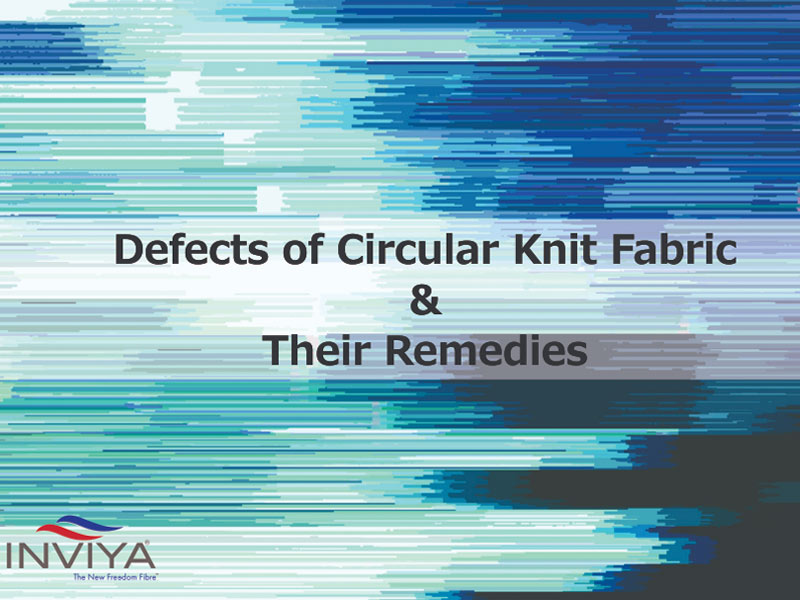
The major defects in Knitted fabrics be it flat knit or circular knit are as below:
1. Barre
2. Streakiness
3. Imperfections
4. Contaminations
5. Snarling
6. Spirality
7. Spandex Jump
8. Spandex miss
1. Barre
Barre is a defect observed in widthwise direction, broad in nature with equal interval over length of fabric
Causes:
• High Yarn Tension
• Count Variation
• Mixing of the yarn lots
• Package hardness variation
Remedies:
• Ensure uniform Yarn Tension on all the feeders.
• The yarn count CV. should be less than 1.2
• Ensure that the yarn being used for Knitting is of the same lot
• Ensure that the hardness of all the yarn packages is uniform using a hardness tester.
2. Streakiness
Streaks as the name suggests are horizontal line which appear in fabric, they are irregularly spaced and can be of various sizes
Causes:
• Faulty winding of the yarn packages.
• Yarn running out of the belt on the Pulley
Remedies:
• Winding of the yarn package should be proper.
• The yarn should be running between the belt and around the pulley.
3. Imperfections
This is defined as the random occurrence of various faults on knitted fabric surface i.e, knots, slubs, neps, thick or thin places etc.
Causes:
If the yarn used is already defective one with defects like, knots, slubs, neps, thick or thin places etc., already present in it
Remedies:
Specify the quality parameters of the yarns to be used for production to the yarn supplier. Proper selection of yarn like carded/ combed/ compact etc. as per your fabric requirement and ensuring supplier gives yarn quality as per specification.
4. Snarls
Snarls appear on the fabric surface in the form of big loops of yarn getting twisted due to the high twist in the yarn.
Causes:
Using high twist yarn in the fabric production of knitting fabric
Remedies:
• Twist in the yarn should be in required TPM.
• Yarn should be properly steam set
5. Contaminations
Contaminations occur when foreign matter such as; dyed fibers, hair, polypropylene, dead fibers etc., are present in the staple yarn or get embedded in the knitted fabric
Causes:
• Presence of dead fibers & other foreign materials, such as; dyed fibers, hair, etc. present in the staple fiber
• Dyed & other types of fibers or fiber fluff flying from the adjacent Knitting machines cling to the yarn being used for knitting & get embedded in the Grey Fabric
• Dust or dirt particles if the area is not cleaned can get embedded in the knitting fabric
Remedies:
• Avoid immature fiber mixing for the yarns to be used for knitting which will lead to less dead fibers
• Strict control measures in the Blow Room which will prevent the mixing of foreign matters in the Cotton
• In case of dyed yarns segregate the Spinning & Knitting Machines, with Plastic Curtains or Mosquito Nets, can prevent the contamination
6. Spirality
Spirality occurs after washing of the garment. After washing if, the seams of the garment are displaced from their actual position on sides and appear on the front and back of the garment, this is known as Spirality.
Causes:
• High T.M. of the Hosiery Yarn
• Uneven Fabric tension on the Knitting machine.
• If the fabric is fed at uneven rate at Stenter, Calender & Compactor machines
Remedies:
• Use the Hosiery yarns of the recommended TM generally 3.5- 3.8 level for Knitting.
• Make sure fabric feeding rate is uniform on both the edges while feeding the fabric to the Stenter, Calender & Compactor machines
• For zero spirality you can use “S” twist, and “Z” twist yarns on alternate feeders
7. Spandex miss plating or spandex jump:
• The cause of this defect is vibration of spandex near to feeder either due to low tension or low draft
• In case the guide pulley varies its rotating speed can create this defect
8. Spandex Miss:
• This defect is caused after every break of spandex.





